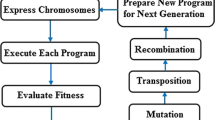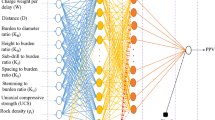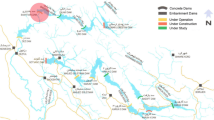Abstract
Ground vibration (GV) is a blasting consequence and is an important parameter to control in mining and civil projects. Previous GV predictor models have mainly been developed considering two factors; charge per delay and distance from the blast-face. However, mostly the presence of the water as an influential factor has been neglected. In this paper, an attempt has been made to modify United State Bureau of Mines model (USBM) by incorporating the effect of water. For this purpose, 35 blasting operations were investigated in Chadormalu iron mine, Iran and required blasting parameters were recorded in each blasting operation. Eventually, a coefficient was calculated and added in USBM model for effect of water. To demonstrate the capability of the suggested equation, several empirical models were also used to predict measured values of PPV. Results showed that the modified USBM model can perform better compared to previous models. By establishing new parameter in the USBM model, a new predictive model based on gene expression programming (GEP) was utilized and developed to predict GV. To show capability of GEP model in estimating GV, linear multiple regression (LMR) and non-linear multiple regression (NLMR) techniques were also performed and developed using the same datasets. The results demonstrated that the newly proposed model is able to predict blast-induced GV more accurately than other developed techniques.













Similar content being viewed by others
References
Singh SP, Xavier P (2005) Causes, impact and control of overbreak in underground excavations. Tunn Undergr Space Technol 20(1):63–71
Zhu Z, Mohanty B, Xie H (2007) Numerical investigation of blasting-induced crack initiation and propagation in rocks. Int J Rock Mech Min Sci 44(3):412–424
Ebrahimi E, Monjezi M, Khalesi MR, Jahed Armaghani D (2015) Prediction and optimization of back-break and rock fragmentation using an artificial neural network and a bee colony algorithm. Bull Eng Geol Environ. doi:10.1007/s10064-015-0720-2
Khandelwal M, Monjezi M (2013) Prediction of backbreak in open-pit blasting operations using the machine learning method. Rock Mech Rock Eng 46(2):389–396
Jahed Armaghani D, Hajihassani M, Tonnizam Mohamad E, Marto A, Noorani SA (2014) Blasting-induced flyrock and ground vibration prediction through an expert artificial neural network based on particle swarm optimization. Arab J Geosci 7:5383–5396
Monjezi M, Rezaei M, Yazdian A (2010) Prediction of backbreak in open-pit blasting using fuzzy set theory. Expert Syst Appl 37:2637–2643
Rezaei M, Monjezi M, Yazdian Varjani A (2011) Development of a fuzzy model to predict flyrock in surface mining. Saf Sci 49:298–305
Khandelwal M, Kankar PK (2011) Prediction of blast-induced air overpressure using support vector machine. Arab J Geosci 4:427–433
Ghasemi E, Sari M, Ataei M (2012) Development of an empirical model for predicting the effects of controllable blasting parameters on flyrock distance in surface mines. Int J Rock Mech Min Sci 52:163–170
Ghasemi E, Ataei M, Hashemolhosseini H (2013) Development of a fuzzy model for predicting ground vibration caused by rock blasting in surface mining. J Vib Control 19(5):755–770
Ghasemi E, Amini H, Ataei M, Khalokakaei R (2014) Application of artificial intelligence techniques for predicting the flyrock distance caused by blasting operation. Arab J Geosci 7(1):193–202
Sari M, Ghasemi E, Ataei M (2014) Stochastic modeling approach for the evaluation of backbreak due to blasting operations in open pit mines. Rock Mech Rock Eng 47(2):771–783
Jahed Armaghani D, Hajihassani M, Marto A, Faradonbeh RS, Mohamad ET (2015) Prediction of blast-induced air overpressure: a hybrid AI-based predictive model. Environ Monit Assess 187(11):1–13
Duvall WI, Fogelson DE (1962). Review of criteria for estimating damage to residences from blasting vibration. US Bureau of Mines R.I. 5968
Khandelwal M, Singh TN (2009) Prediction of blast-induced ground vibration using artificial neural network. Int J Rock Mech Min Sci 46:1214–1222
Kuzu C (2008) The importance of site-specific characters in prediction models for blast-induced ground vibrations. Soil Dyn Earthq Eng 28(5):405–414
Monjezi M, Ahmadi M, Sheikhan M, Bahrami A, Salimi AR (2010) Predicting blast-induced ground vibration using various types of neural networks. Soil Dyn Earthq Eng 30(11):1233–1236
Dehghani H, Ataee-pour M (2011) Development of a model to predict peak particle velocity in a blasting operation. Int J Rock Mech Min Sci 48:51–58
Singh TN, Singh V (2005) An intelligent approach to prediction and control ground vibration in mines. Geotech Geol Eng 23:249–262
Jahed Armaghani D, Momeni E, Abad SVANK, Khandelwal M (2015) Feasibility of ANFIS model for prediction of ground vibrations resulting from quarry blasting. Environ Earth Sci 74:2845–2860
Bureau of Indian Standard Criteria for safety and design of structures subjected to underground blast. ISI Bull IS-6922, 1973
New BM (1986) Ground vibration caused by civil engineering works. Transport and road research laboratory research report, 53, 19
Basu D, Sen M (2005) Blast induced ground vibration norms—a critical review. National seminar on policies. Statutes and Legislation in Mines, Kharagpur, pp 112–113
Crandell FJ (1949) Ground vibrations due to blasting and its effects upon structures. J. Boston Soc Civ Eng 30:222–245
Blair BE, Duvall WI (1954) Evaluation of gauges for measuring displacement, velocity and acceleration of seismic pulses. USBM RT 5073:21
Ambraseys NR, Hendron AJ (1968) Dynamic behaviour of rock mass. John Wiley and Sons, London, pp 203–207
Langefors U, Kihlstrom B (1973) The modern technique of rock blasting, seconded. Wiley Publisher, New York
Ghosh A, Daeman JK (1983) A simple new blast vibration predictor based on wave propagation laws, The 24th U.S. Symposium on Rock Mechanics (USRMS)
Singh PK, Vogt W, Singh RB (1996) Blasting side effects Investigations in an open cast coal mine in India. Int J Mini Reclamat Environ 10:155–159
Duvall WI, Petkof B (1959) Spherical propagation of explosion generated strain pulses in rock. USBM Rep Investig 5483:21
Hajihassani M (2014) Jahed Armaghani D, Marto A, Tonnizam Mohamad E. Ground vibration prediction in quarry blasting through an artificial neural network optimized by imperialist competitive algorithm. Bull Eng Geol Environ. doi:10.1007/s10064-014-0657-x
Hasanipanah M, Monjezi M, Shahnazar A, Jahed Armaghani D, Farazmand A (2015) Feasibility of indirect determination of blast induced ground vibration based on support vector machine. Measurement 75:289–297
Hagan TN, Kennedy BJ (1977) A practical approach to the reduction of blasting nuisance from surface operation. Aust Min 69:36–46
Mather W (1984) Factors affecting magnitude and frequency of blast-induced ground and air vibrations. Inst Min Metall Trans 93:173–180
Blair DP, Jiang JJ (1995) Surface vibrations due to a vertical column of explosive. Int J Rock Mech Min Sci 32:149–154
Roy PP (1998) Characteristics of ground vibrations and structural response to surface and underground blasting. Geotech Geol Eng 16:151–166
Blair DP (1999) Statistical models for ground vibration and airblast. Fragblast 3:335–364
Hakan AK, Adnan K (2008) The effect of discontinuity frequency on ground vibrations produced from bench blasting: a case study. Soil Dyn Earthq Eng 28(9):686–694
McDowell PW (2002) Geophysics in Engineering Investigations (CIRIA), Construction Industry Research
Singh TN, Verma AK (2010) Sensitivity of total charge and maximum charge per delay on ground vibration. Geomat Nat Hazards Risk 1(3):259–272
Verma AK, Singh TN (2009) A Neuro-Genetic approach for prediction of compressional wave velocity of rock and its sensitivity analysis. Int J Earth Sci Eng 2(2):81–94
Khandelwal M, Jahed Armaghani D (2015) Prediction of drillability of rocks with strength properties using a hybrid GA-ANN technique. Geotech Geol Eng. doi:10.1007/s10706-015-9970-9
Tonnizam Mohamad E, Noorani SA, Jahed Armaghani D, Saad R (2012) Simulation of blasting induced ground vibration by using artificial neural network. Electron J Geotech Eng 17:2571–2584
Momeni E, Nazir R, Jahed Armaghani D, Sohaie H (2015) Bearing capacity of precast thin-walled foundation in sand. Geotech Eng. doi:10.1680/jgeen.14.00177
Khandelwal M, Singh TN (2010) Artificial neural networks as a valuable tool for well log interpretation. Pet Sci Technol 28(14):1381–1393
Kanungo DP, Arora MK, Sarkar S, Gupta RP (2006) A comparative study of conventional, ANN black box, fuzzy and combined neural and fuzzy weighting procedures for landslide susceptibility zonation in Darjeeling Himalayas. Eng Geol 85:347–366
Sakellariou M, Ferentinou M (2005) A study of slope stability prediction using neural networks. Geotech Geol Eng 24(3):419–445
Iphar M, Yavuz M, Ak H (2008) Prediction of ground vibrations resulting from the blasting operations in an open-pit mine by adaptive neurofuzzy inference system. Environ Geol 56:97–107
Fisne A, Kuzu C, Hüdaverdi T (2011) Prediction of environmental impacts of quarry blasting operation using fuzzy logic. Environ Monit Assess 174:461–470
Teodorescu L, Sherwood D (2008) High energy physics event selection with gene expression programming. Comput Phys Commun 178:409–419
Alkroosh I, Nikraz H (2011) Correlation of pile axial capacity and CPT data using gene expression programming. Geotech Geol Eng 29(5):725–748
Mollahasani A, Alavi AH, Gandomi AH (2011) Empirical modeling of plate load test moduli of soil via gene expression programming. Comput Geotech 38(2):281–286
Ozbek A, Unsal M, Dikec A (2013) Estimating uniaxial compressive strength of rocks using genetic expression programming. J Rock Mech Geotech Eng 5(4):325–329
Wyllie DC, Mah CW (2004) Rock Slope Engineering Civil and Mining, 4th edn. Taylor & Francis, Abingdon
Zhang GJ (1996) A study of free toe-space explosive loading and its application in open pit blasts, Fragblast5, Montreal, Canada
Mandal SK (2007) An investigation on the effect of geo–technical and blast design parameters on smooth blasting, PhD thesis. Department of Mining Engineering Bengal Engineering and Science University, Shibpur
Ferreira C (2001) Gene expression programming: a new adaptive algorithm for solving problems. Complex Syst 13(2):87–129
Ferreira C (2006) Gene expression programming: mathematical modeling by an artificial intelligence, 2nd edn. Springer-Verlag, Germany, p 478
Keshavarz A, Mehramiri M (2015) New gene expression programming models for normalized shear modulus and damping ratio of sands. Eng Appl Artif Intell 45:464–472
Steeb W-H (2011) The nonlinear workbook: chaos, fractals, cellular automata, neural networks, genetic algorithms, gene expression programming, support vector machine, wavelets, hidden Markov models, fuzzy logic with C++, Java and Symbolic C++ programs. World Scientific, Singapore
Güllü H (2012) Prediction of peak ground acceleration by genetic expression programming and regression: a comparison using likelihood-based measure. Eng Geol 141:92–113
Goldberg DE (1989) Genetic Algorithms in Search, Optimization and Machine Learning. Addison-Wesley, Boston
Yang Y et al (2013) A new approach for predicting and collaborative evaluating the cutting force in face milling based on gene expression programming. J Netw Comput Appl 36(6):1540–1550
Yassin MA, Alazba A, Mattar MA (2016) Artificial neural networks versus gene expression programming for estimating reference evapotranspiration in arid climate. Agric Water Manag 163:110–124
Nelson M, Illingworth WT (1990) A practical guide to neural nets. Addison-Wesley, Reading
Swingler K (1996) Applying neural networks: a practical guide. Academic Press, New York
Shirani Faradonbeh R, Monjezi M, Jahed Armaghani D (2015) Genetic programing and non-linear multiple regression techniques to predict backbreak in blasting operation. Eng Comput. doi:10.1007/s00366-015-0404-3
GEPSOFT. GeneXproTools. Version 4.0 (2006) http://www.gepsoft.com/
Bahrami A, Monjezi M, Goshtasbi K, Ghazvinian A (2011) Prediction of rock fragmentation due to blasting using artificial neural network. Eng Comput 27(2):177–181
Yagiz S, Gokceoglu C, Sezer E, Iplikci S (2009) Application of two non-linear prediction tools to the estimation of tunnel boring machine performance. Eng Appl Artif Intel 22(4):808–814
Acknowledgments
The cooperation of Mr. Nikravan, director of the Asphalttous Company, in providing the required information of blasting operation of Chadormalu iron mine is highly appreciated.
Author information
Authors and Affiliations
Corresponding author
Rights and permissions
About this article
Cite this article
Monjezi, M., Baghestani, M., Shirani Faradonbeh, R. et al. Modification and prediction of blast-induced ground vibrations based on both empirical and computational techniques. Engineering with Computers 32, 717–728 (2016). https://doi.org/10.1007/s00366-016-0448-z
Received:
Accepted:
Published:
Issue Date:
DOI: https://doi.org/10.1007/s00366-016-0448-z




